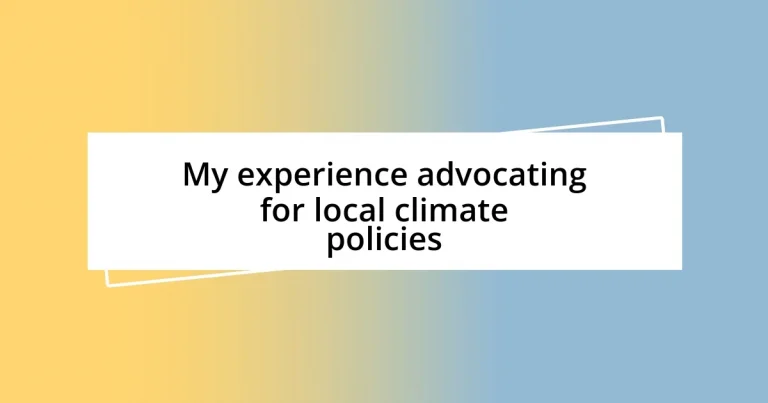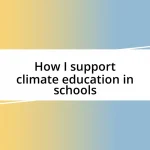Key takeaways:
- The author’s journey in climate advocacy began with personal experiences, highlighting the importance of storytelling and emotional connection in mobilizing community action.
- Understanding local climate policies, including emission reduction goals and community engagement, is vital for effective advocacy and creating actionable change.
- Building coalitions with diverse stakeholders fosters collaboration and strengthens advocacy efforts, emphasizing the significance of nurturing relationships and shared goals.

My journey in climate advocacy
My journey in climate advocacy began with a simple question: how could I make a difference? One summer, while volunteering at a local park cleanup, I stumbled upon a group discussing the impact of pollution on our community. It hit me then how interconnected everything was—the air we breathe, the water we drink, and the future we leave behind.
I vividly remember the first time I spoke at a town hall meeting. My hands trembled, but my heart raced with purpose. I shared my fears and hopes for our environment, feeling the weight of responsibility wash over me. That moment solidified my resolve. It was clear to me that advocacy wasn’t just about numbers and policies; it was about the people and the planet we cherish.
As I delved deeper into research, I was often struck by the urgency of our situation. I’ve attended rallies where the overwhelming energy of passionate individuals left me in awe. Have you ever felt the collective strength of a crowd united toward a common goal? It ignited something in me—a desire to harness that power and turn it into actionable change, to push for policies that truly represent the voices of our community.

Understanding local climate policies
Understanding local climate policies is essential for effective advocacy. I remember attending a workshop where local leaders spoke about the significance of these policies in addressing climate change. It was an eye-opener for me to realize how these regulations can shape not just our environment, but also our economy and community health.
Here are some key components that define local climate policies:
- Emission Reduction Goals: Setting specific targets for lowering greenhouse gas emissions based on scientific recommendations.
- Energy Efficiency Standards: Implementing guidelines for buildings and infrastructure to minimize energy consumption.
- Renewable Energy Initiatives: Promoting the use of resources like solar and wind to create sustainable energy avenues.
- Green Space Development: Encouraging the protection and expansion of parks and natural habitats to enhance our local ecosystems.
- Community Engagement: Involving residents in decision-making processes to ensure policies reflect the needs and values of the community.
Understanding these facets was a breakthrough for me; it helped me frame my arguments in discussions, pushing for policies that weren’t just theoretical but practical and achievable. It’s fascinating to see how these elements interconnect and drive real change on the ground.

Identifying key stakeholders in advocacy
Identifying key stakeholders in advocacy is essential for any successful initiative. During my early days in advocacy, I discovered that stakeholders aren’t just policymakers. They can range from local businesses and non-profits to community leaders and activists. Once, I joined a coalition meeting where a local entrepreneur shared how their company was committed to sustainability. It opened my eyes to the collaborative potential we have when diverse groups come together under a shared vision.
Understanding the interests and motivations of each stakeholder is crucial. For instance, I remember engaging with a community leader who was initially skeptical of climate policies. By taking the time to listen to their concerns, I learned that their hesitation stemmed from a lack of trust in how proposals would impact their constituents. This encounter taught me that advocacy isn’t just about pushing for change; it’s about building bridges and ensuring everyone’s voice is heard.
Building an effective advocacy strategy requires mapping out these key players and determining their influence. I created a simple stakeholder matrix during a planning session, which helped our group visualize who we could engage and how. This experience reinforced my belief that every stakeholder has a role to play in the climate movement, and acknowledging their importance strengthens our advocacy efforts.
| Stakeholder Type | Potential Contributions |
|---|---|
| Local Government | Policy formulation and regulation enforcement |
| Businesses | Sustainability initiatives and funding |
| Community Groups | Grassroots mobilization and education |
| Scientists/Academics | Research and evidence-based recommendations |
| Media | Raising awareness and disseminating information |

Strategies for effective communication
When it comes to effective communication in advocating for local climate policies, I’ve found that storytelling can be incredibly powerful. Sharing personal experiences or compelling community narratives helps to humanize the issue and make it relatable. I recall a time when I shared a heartfelt story about a neighborhood affected by flooding. Seeing people’s expressions change as they connected emotionally with the story reminded me how engaging narratives can inspire action.
Clarity is another vital strategy—it’s essential to present information in simple, accessible language. I’ve often witnessed the confusion that technical jargon can create, even among people passionate about climate change. During a community meeting, I pivoted from complex terminology to plain language, which sparked a more meaningful discussion. Moreover, I’ve learned that visuals, like infographics, can convey complex ideas quickly and effectively, leading to a deeper understanding among diverse audiences.
Finally, asking questions can turn a presentation into a two-way conversation. I often encourage engagement by posing reflective questions, like, “What does a sustainable community look like to you?” This approach not only invites others to share their views but also fosters a sense of ownership over the issues at hand. When participants express their thoughts, it’s a reminder of the collective journey we are on and reinforces the belief that everyone has a role in advocating for positive change.

Building coalitions for change
Building coalitions for change is all about finding common ground. I remember my first local climate summit where diverse group representatives gathered—environmentalists, business owners, educators, and citizens. Initially, it felt daunting to address such a variety of perspectives, but as we shared our individual stories, I realized how much we all wanted the same thing: a sustainable future. It got me thinking, how often do we overlook the shared goals that unite us?
As we dove deeper into discussions, I noticed how collaboration transformed our approach to challenges. At one point, a local farmer shared their struggles with soil erosion, which led to a rich dialogue on sustainable practices that everyone could support. That moment illuminated the potential of leveraging each other’s strengths. Their insights reminded me how essential it is to actively listen to one another; sometimes a farm’s needs can inspire urban policy change. Have you ever experienced a moment where listening opened unexpected doors?
Through these experiences, I’ve come to appreciate the importance of nurturing relationships within the coalition. I found that regular check-ins can significantly strengthen our bonds and commitment to our shared mission. In one instance, we established monthly gatherings that fostered trust and maintained momentum in our initiatives. It was more than just networking; we became allies in a meaningful journey. These connections turned into friendships, making our advocacy efforts feel less like work and more like a cause we were all passionate about. Isn’t it incredible how relationships can amplify our voices for change?

Measuring success in climate initiatives
Measuring success in climate initiatives often requires a multifaceted approach. I remember attending a local forum where we discussed the outcomes of our recent tree-planting project. Initially, it felt challenging to quantify success beyond just counting the number of trees planted. However, integrating community surveys revealed how residents felt more connected to nature and proud of their participation. This kind of feedback painted a richer picture of our impact, emphasizing that success isn’t just about numbers; it’s also about community engagement and emotional resonance.
One of the most eye-opening moments for me came during a community workshop on energy conservation. We tracked not only the kilowatt-hours saved but also surveyed participants about their newfound awareness of energy use. Seeing how knowledge translated into action—like families opting to install solar panels or reduce their electricity consumption—was incredibly rewarding. I often ask myself, “What does success truly look like?” From my experience, it’s a blend of measurable results and the stories of transformation that unfold within our communities.
Looking beyond the conventional metrics can be revealing, too. Metrics such as reduced greenhouse gas emissions tend to dominate discussions, but I’ve found that the social impacts—like increased community resilience in the face of climate change—are crucial indicators. For instance, one project I was involved with not only reduced flood risk but also empowered residents through educational workshops. Have you ever stopped to think about how much of a ripple effect these initiatives can have? By addressing both environmental and social aspects, we can truly gauge the success of our climate initiatives in a way that inspires ongoing collective effort.














